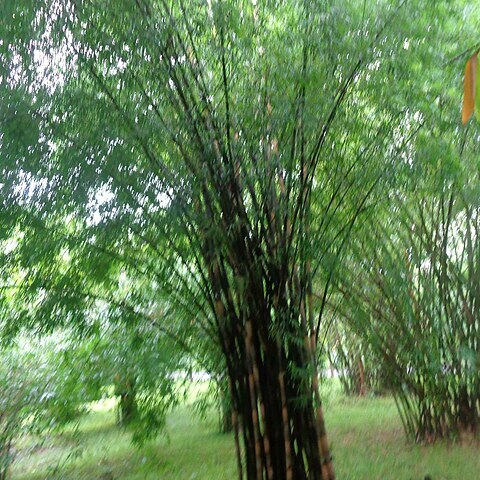Culms 15–20 m, 7–15 cm in diam., apically nodding; internodes gray-green, 40–65 cm, initially with white powdery chaff; wall thick; nodes slightly prominent, several basal nodes with rings of aerial roots; branching only from mid-culm up. Branches many, clustered, arched, slender. Culm sheaths quite persistent, short, broad, leathery, rigid, densely pale brown or silky white hairy, apex curved-truncate; auricles subequal, not slanted downward, projecting up or down, falcate, broadly belt-shaped, 7–8 × 2.5–3 cm, strongly wrinkled; oral setae dense, 1–1.5 cm, thick, scabrous; ligule 7–8 mm, shortly fimbriate; blade erect, nearly symmetrical, broadly lanceolate, base slightly narrowed and joined to auricles for ca. 2.5 cm, ca. 1/3 width of sheath apex, abaxially brown silky hairy, apex acute, sharply tipped. Leaf blade linear to narrowly lanceolate, 15–20 × 0.9–1.5 cm, both surfaces initially pubescent, later adaxially hairy near base and abaxially along midrib. Pseudospikelets embraced by sheathlike bracts; bracts terete, 1–1.5 cm, glossy; florets 2 or 3, apical one sterile; rachilla segments flat, glabrous. Glumes 3, ovate, apex mucronate; lemma ovate, many veined, apex mucronate; palea lanceolate, about as long as or slightly longer than lemma, keels glabrous, apex acute; lodicules 3, posterior 1 smaller, suborbicular, 3–5-veined, margins ciliolate. Anthers purple, apex obtuse, sometimes finely tipped. Ovary ovoid, apex hairy; style short; stigmas 3, white hairy. Caryopsis obovoid, unilaterally compressed, ca. 5 mm, apex hairy, with persistent style base.
More
A densely tufted bamboo. The culms or stems are erect but can curve outwards at the top. They are 15-25 m tall. They are 7.5-15 cm across. They are greyish green when mature. The internodes are 60-100 cm long. The nodes are thickened. There are branches from the nodes in the upper half of the stem. The culm sheath is 15-17.5 cm long by 30-35 cm wide. The leaf blade is sword shaped and 7.5-20 cm long by 8-20 mm wide. It is slightly rough with small lumps. The life cycle is probably 60 years. Plants die after flowering.

